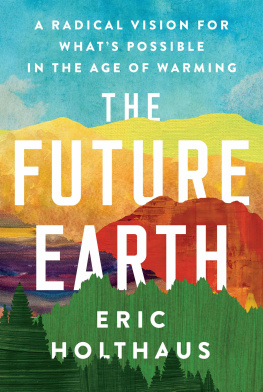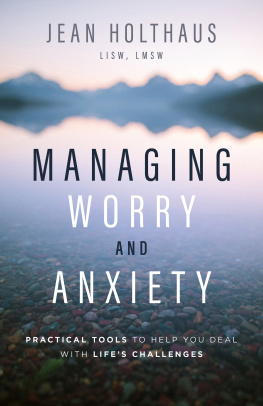Eric Holthaus - The Future Earth: A Radical Vision for Whats Possible in the Age of Warming
Here you can read online Eric Holthaus - The Future Earth: A Radical Vision for Whats Possible in the Age of Warming full text of the book (entire story) in english for free. Download pdf and epub, get meaning, cover and reviews about this ebook. year: 2020, publisher: HarperCollins, genre: Romance novel. Description of the work, (preface) as well as reviews are available. Best literature library LitArk.com created for fans of good reading and offers a wide selection of genres:
Romance novel
Science fiction
Adventure
Detective
Science
History
Home and family
Prose
Art
Politics
Computer
Non-fiction
Religion
Business
Children
Humor
Choose a favorite category and find really read worthwhile books. Enjoy immersion in the world of imagination, feel the emotions of the characters or learn something new for yourself, make an fascinating discovery.
- Book:The Future Earth: A Radical Vision for Whats Possible in the Age of Warming
- Author:
- Publisher:HarperCollins
- Genre:
- Year:2020
- Rating:5 / 5
- Favourites:Add to favourites
- Your mark:
- 100
- 1
- 2
- 3
- 4
- 5
The Future Earth: A Radical Vision for Whats Possible in the Age of Warming: summary, description and annotation
We offer to read an annotation, description, summary or preface (depends on what the author of the book "The Future Earth: A Radical Vision for Whats Possible in the Age of Warming" wrote himself). If you haven't found the necessary information about the book — write in the comments, we will try to find it.
Eric Holthaus: author's other books
Who wrote The Future Earth: A Radical Vision for Whats Possible in the Age of Warming? Find out the surname, the name of the author of the book and a list of all author's works by series.
The Future Earth: A Radical Vision for Whats Possible in the Age of Warming — read online for free the complete book (whole text) full work
Below is the text of the book, divided by pages. System saving the place of the last page read, allows you to conveniently read the book "The Future Earth: A Radical Vision for Whats Possible in the Age of Warming" online for free, without having to search again every time where you left off. Put a bookmark, and you can go to the page where you finished reading at any time.
Font size:
Interval:
Bookmark:
Contents
For Roscoe and Zeke
If I cant save us
then let me feel you
happy and safe
under my chin.
If this will drown
or burn
then let us drink starlight
nap under trees
sing on beaches
the morning rush to sit indoors is for
what, again?
If we are dying
then let me rip open
and bleed Love,
spill it, spend it
see how much
there is
the reward for misers is
what, again?
If this life is ending
then let me begin
a new one
Lynna Odel (2019), used with permission
Contents
I n September 2017, Puerto Rico was just beginning to recover from one of the worst multiyear droughts in its history. Faced with severe water shortages during the height of the drought, the islands government rationed water use for two hundred thousand residents in the San Juan area, a drastic step worsened by years of austerity and colonial neglect. People there were allowed to run their taps only once every three days, forgoing one of the basic requirements of life.
Then Hurricane Maria struck, beginning the worst humanitarian crisis in modern American history.
In the span of a few hours, Hurricane Marias 155-mile-per-hour winds and torrential rains triggered a months-long power outage that reshaped the basics of civilization in Puerto Rico. Following the storm, survivors struggled for weeks to find potable water, edible food, reliable shelter, and adequate health care. With no other options, some residents of Puerto Rico were forced to collect drinking water from toxic waste sites. Hundreds of people died because hospitals, even if they were physically accessible, didnt have electricity to provide basic services.
For survivors, Maria looked and felt like an utter reimagining of reality. Firsthand stories carried waves of shock and anguish.
In the early days after Maria, Ly Prez, a student at the University of Puerto Rico, told me via text message that the only way she and her fellow students knew what was happening around them was by listening to the radio. [Todays] the first time I saw pictures, and its absolutely horrifying. They kept mentioning the word disaster, and your mind would create scenarios. But in no way does it compare to the absolutely heartbreaking reality.
We have reached a point at which all weather, in every season, and in every country on Earth, is directly connected to the changes weve inflicted on our planets atmosphere. Hurricane Maria was no exception. A 2019 study in the journal Geophysical Research Letters found that global warming made Marias disastrous floods nearly five times more likely than it would have been in 1956, when high-quality rainfall record keeping began in Puerto Rico. Lead author David Keellings told the American Geophysical Union that Maria is more extreme in its precipitation than anything else that the island has ever seen.
Hurricane Maria damaged or destroyed about 30 million trees, inflicting profound and unprecedented changes on the landscape. With the climate warming so quickly, biologists in Puerto Rico think the forests Maria destroyed will never return to their previous diversity. Many of the islands largest and slowest-growing hardwood trees, like tabonuco and balata, suffered the worst damage. Their vast canopies provide habitats for birds, bats, and tree frogs. If future hurricanes are as strong (or even stronger) than Maria, Puerto Ricos forests will eventually feature only smaller and shorter trees that are more resilient to high winds and scouring floods, which will leave local species without shelter. More than a year after the storm made landfall, satellite images showed that the island appeared definitively less green.
The storm of Hurricane Maria still hasnt let up. A full-fledged mental health crisis is ongoing throughout the island, the largest psychosocial disaster in the United States according to Joseph Prewitt Diaz, disaster mental health advisor for the American Red Cross. The slow recovery has created a living emergency, a new normal that permeates daily lifecharacterized by despair, anxiety, and post-traumatic stresswhich is more typical of refugee camps and conflict zones.
None of this was inevitable. None of this was a surprise. What is happening in Puerto Rico is the product of centuries of decisions made within a destructive system. Weve known this for centuries, thanks in large part to the people whose voices were too often deemed dangerous or unworthy of our attention. Scientists are now certain that our use of fossil fuels and our destruction of the planets ecosystems are quickly bringing the future of human civilization into doubt. My goal with this book is to help you imagine your own part in building a better world that works for everyone, regardless of status or class or gender. And to remind you that you were born at exactly the right time to help change everything.
Because we refused to take action for decades, climate change is no longer just about science. It is now, at heart, an issue of justice. The fact that each year we are continuing to set new record highs in greenhouse gas emissions even as our planet is rapidly warming is a shocking symptom of a larger problem in the way our society is structured. An issue of justice, climate change is also a living emergency that touches everyone and every part of society, which makes it impossible to disentangle in any meaningful way the effects of increasingly extreme weather and the unfair system that caused it. The evidence is all around us: we need to embark rapidly on a different path.
But how?
* * *
The Latin root of the word disaster means ill-starred, literally a malevolent omen from the heavens. But climate-change-related disasters are no longer a matter of bad luck. We have tilted the odds toward catastrophe, particularly in the places that did the least to cause the problem. Meteorology has advanced to the point that we can now predict when and where disasters will take place. We also know that, due to the way our society is structured, the most economically and socially vulnerable parts of the planet will bear the brunt of these disastersthe people, like the survivors of Hurricane Maria in Puerto Rico, who too often experience the worst of the injustices of history.
Today, climate change compounds natural disasters, giving people less time to recover before they are plunged back into crisis mode. Residents of small islands like Puerto Rico already face limited resources for fresh water. A 2018 study found that drought in the Caribbean is increasing in severityeven as hurricanes grow stronger and downpours get more intense. And this compounding of social and climate emergencies is happening all over the world, every single year.
In 2016, the year before Maria, on the other side of the world, Cyclone Winston rapidly strengthened to the most powerful storm ever measured in the Southern Hemisphere, just hours before its landfall in Fiji. In an address to the nation following the storm, Fijian president Jioji Konrote vowed that the country would do whatever is in its power to persuade the global community about the root cause: climate change. This is a fight we must win, he said. Our entire way of life is at stake. Years after landfall, as recovery drags on rainy season after rainy season, schools and families are still housed in government-issued tents.
In 2017, just a few days before Hurricane Maria hit Puerto Rico, another hurricane tore through the Caribbean. Hurricane Irma, the strongest hurricane ever to make landfall anywhere in the Atlantic Ocean, hit the island of Barbuda with winds of up to 185 miles per hour. It demolished 90 percent of the island. The entire population fled, leaving the island completely uninhabited for the first time in hundreds of years. By law and tradition, land on the island is owned communally by its residents, but in the wake of the storm, private developers are now trying to pressure the government to change the law in order to encourage more tourism.
Next pageFont size:
Interval:
Bookmark:
Similar books «The Future Earth: A Radical Vision for Whats Possible in the Age of Warming»
Look at similar books to The Future Earth: A Radical Vision for Whats Possible in the Age of Warming. We have selected literature similar in name and meaning in the hope of providing readers with more options to find new, interesting, not yet read works.
Discussion, reviews of the book The Future Earth: A Radical Vision for Whats Possible in the Age of Warming and just readers' own opinions. Leave your comments, write what you think about the work, its meaning or the main characters. Specify what exactly you liked and what you didn't like, and why you think so.






